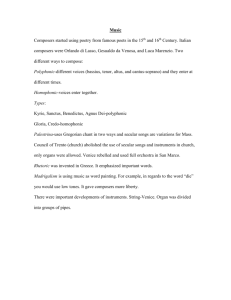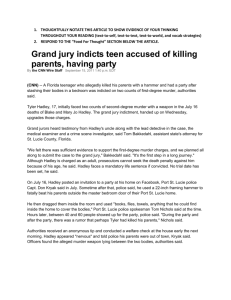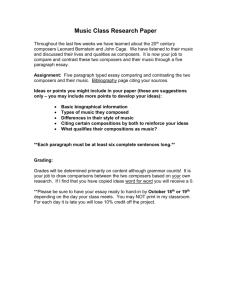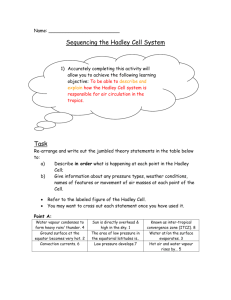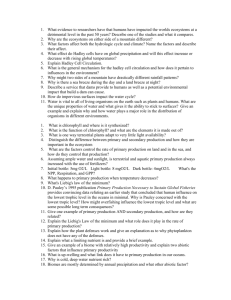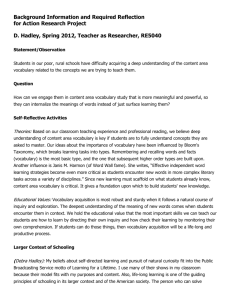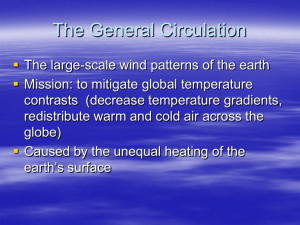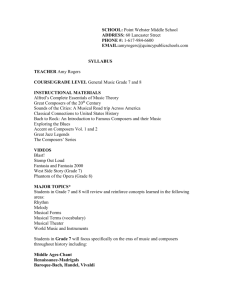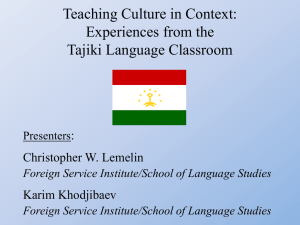NACUSA History - Music
advertisement
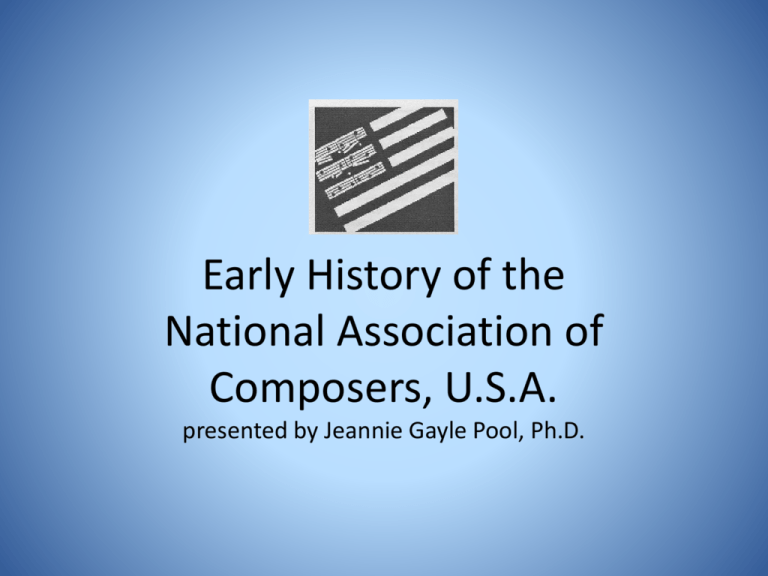
Early History of the National Association of Composers, U.S.A. presented by Jeannie Gayle Pool, Ph.D. Founded in 1933 The organization, originally called the National Association for American Composers and Conductors (NAACC) was founded by American composer and conductor, Henry Hadley. Past Presidents include Henry Hadley Leon Barzin Lawrence Tibbett Sigmund Spaeth William Schroeder Robert Russell Bennett Paul Creston Herman Neuman, Paul Price John Vincent Daniel Kessner Marshall Bialosky Deon Nielsen Price Greg A.Steinke The purpose of the organization was “to arrange and encourage performances of works by American composers and to help develop understanding and friendly cooperation between composers and conductors.” Henry Hadley (1871-1937) studied piano, violin and conducting with his father, a Somerville, MA, public school music teacher. Later he studied composition with Stephen A. Emery and George W. Chadwick. He went to Vienna for a year in 1894 and studied with Eusebius Mandyczewski, a famous musicologist and editor of editions of the works of Schubert, Beethoven, Haydn, Brahms and Caldera. In 1896 he accepted a position formerly held by Horatio Parker as a teacher at St. Paul’s School in Garden City, NY. He made his debut as a conductor in NY in 1904 and began regular tours of Europe. Hadley returned to Europe to study with Ludwig Thuille in Munich, who introduced him to the music of contemporaries Reger, Mahler, and Richard Strauss. Hadley met Strauss in London and who, along with Chadwick, were Hadley’s greatest influences as a composer. In 1909 he was appointed conductor of the Seattle Symphony and in 1911 became the first conductor of the San Francisco Symphony. • He left the position in San Francisco in 1915 to become a full time composer and continued to guest conduct the London Symphony and the Boston Symphony. He was active in composing music for “silent films,” including several full-length scores for feature films. • From 1920-1927, he was the associate conductor of the New York Philharmonic and in 1929 founded the Manhattan Symphony Orchestra with the goal of presenting works of American composers on each and every program. Prolific Composer and Conductor • He toured South America in 1927 and Japan in 1930, where he conducted the New Symphony Orchestra in Tokyo. • In 1934 he founded the Berkshire Music Festival, now known as Tanglewood. • By the time of his death in 1937, he had written 14 operas, 5 symphonies, tone poems, and other orchestral works, chamber music, piano music, oratorios, cantatas and more than 200 songs. • Henry Hadley believed that composers needed to join with conductors in organizations to promote contemporary music and therefore established the NAACC. How could American composers of orchestral music get performed if they didn’t know any conductors? • In 1918 he married Inez Barbour, a well known concert singer who had sung the American premiere of Mahler’s Symphony No. 8 with Leopold Stokowski conducting. When Hadley died, Mrs. Hadley decided to use her husband’s royalties to carry on his mission to promote American composers. This was an amazing effort, especially during The Great Depression. Mrs. Hadley did a remarkable job of running (and funding) the organization until her death in 1971. The focus of her efforts was on presenting concerts, including world premiere performances and revival performers of American works from the prerevolutionary period. Panel discussion at NYC Hadley Studio Many events were presented at the Henry Hadley Studio, located at 15 West 67th Street (near Central Park West), including musicales, panel discussions, lectures, and social events. Many of Henry Hadley’s friends and colleagues kept NAACC alive in his memory. His contacts were called upon year after year to help American composers. NAACC began annual presentation of the Henry Hadley Medal to American music advocates. For examples, it was presented to Deems Taylor in 1943 for his broadcasts for the New York Philharmonic-Symphony Society. Recipients of the Medal included: Howard Hanson, Nicolai Sokoloff, Gene Buck, Dr. Sigmund Spaeth, Deems Taylor, Mrs. Edward MacDowell, Honorable Fiorello LaGuardia, John Simon Guggenheim Memorial Foundation, Pierre Monteux, Nadia Boulanger, Charles E. Ives, Edwin Franko Goldman, Louisville Kentucky Philharmonic Society, Dr. Walter H. Hodgson, National Music Council, Ada Holding Miller, Martha Graham, Edwin Hughes, Ernest Bloch, Samuel Barber, Leopold Stokowski, Douglas Moore, ASCAP, Henry Cowell, Inez Barbour Hadley, Aaron Copland, Dr. Joseph E. Maddy, and Morton Gould The last Henry Hadley Medal was presented in 1967. • In the late 1940s and throughout the 1950s, NAACC presented orchestral concerts in New York City at Town Hall which were broadcast over WNYC. • Many years NAACC presented a six-week American Music Festival in NYC in cooperation with WNYC Radio. • The organization also had an annual membership meeting/awards dinner at the Waldorf Astoria Hotel where the Henry Hadley Medal was presented. Citations of Honor from NAACC were presented: 1939-1940: Serge Koussevitzky, Howard Barlow, Roy Harris, Harold Morris, WNYC, and Francis D. Perkins 1940-41: Frances Densmore, John Tasker Howard, Mrs. Vincent Hilles Ober, John Charles Thomas, Joseph Barone, Edwin D. McArthur, C.C. Cappel, Paul Creston, and Morton Gould. 1941-42: Leon Barzin, Frank Black, Charles Wakefield Cadman, Station WQXR, Robert Russell Bennett, Eddy Brown, Edwin Fleisher, N.Y. Hearld-Tribune, Albert Spaulding, William Schuman, and Mills Music Company. 1942-43: Arturo Toscanini, Robert Shaw, Miklos Rozsa, the Roth Quartet, Paul Creston, Irving Berlin, Gail Kubik, Edwin Hughes, Helen Traubel, R.C.A.-Victor Mfg. Co., Maj. Edward Bronson, and John G. Paine. 1943-44: Newbold Morris, Samuel Barber, Richard Rodgers, Leonard Bernstein, Andre Kostelanetz, Quincy Porter, Ernö Balogh, Abram Chasins, Alfred Newman, Eleanor Steber, and Leonard Warren. 1944-45: Music Branch Special Service Div. Armed Forces, Eastman School of Music, Motion Picture Industries, Dr. Frances Elliott Clark, Citizens Comm.. of Army & Navy, Inc. 1945-46: Dean Dixon, Alice M. Ditson Fund, and Claire Reis . 1946-47: Martha Graham, Bernard Herrmann, Walter W. Naumberg, Rose Bampton, and Ezler Solomon. 1947-48: Henry H. Reichhold, Douglas Moore, Karl Krueger, Geoffrey O’Hara, Frederick Fennell, and Charles Triller. 1948-49: Beveridge Webster, William Grant Still, Lazar Saminsky, Paul Bowles, Alan Carter, and Lazlo Halasz. 1949-50: Leo Sowerby, Alfred Frankenstein, Adrian Michaelis, and Edward Johnson. The organization maintained a library of scores by American composers which was donated to the New York Public Library. Mrs. Hadley with the collection and a bust of her husband. From 1933 until 1970, NAACC published an Annual Bulletin which listed its events and members. The organization was diligent in its promotion of its events and its members. At its height, the organization boasted 1,200 members. We are hoping to find copies of this publication for our archive. With the decline of Mrs. Hadley’s health, the Los Angeles chapter rose to prominence in the organization. In 1975 John Vincent reorganized NAACC, moved it from NY to Los Angeles, and changed the name to the National Association of Composers USA. The Los Angeles chapter was very active in the 1950s and 60s and included many prominent film and television music composers including Miklos Rozsa, David Raksin, Franz Waxman, Dimitri Tiomkin, Mario Castelnuovo-Tedesco, Max Steiner, Lionel Newman, Arthur Lange, George Tremblay, and the music faculties of USC and UCLA. John Vincent was Chairman of the UCLA Music Department for many years and had been active in the Los Angeles Chapter of NAACC. Naomi Reynolds (1894-1990) edited the LA Chapter Newsletter for many years and sent out press releases for LA concerts. When John Vincent died suddenly, his former student, Daniel Kessner, became President. • In 1976, the quarterly journal Composer/USA was started. • In the late 1970s, NACUSA began awards luncheons on Los Angeles where certificates were awarded performers, composers, and others for their advocacy of contemporary composers. Among those honored: Leonard Stein, Marni Nixon, Naomi Reynolds, Delores Stevens, Su Harmon, Karen Ervin, Ellis Kohs, Robert Linn, Frank Campo, Aurelio de la Vega, Robert Miller, Phillip Rehfeldt, Bert Turetzky, Joann Falletta, Byong-kon Kim, Althea Waites, Steven Stucky, Jeannie Gayle Pool, Nancy Bloomer Deusen, and George Heussenstamm. Chapters In the early days of NAACC, there were chapters in New York and Philadelphia. Additional chapters were established in Los Angeles, Chicago, Santa Cruz, Washington, D.C. and in Colorado. • In 1983, the 50th anniversary concert was presented at Carnegie Hall’s Weil Recital Hall. • In 2008, the 75th anniversary of the organization was celebrated with a series of chamber music concerts in Los Angeles. Active NACUSA Chapters Today • Cascadia • Los Angeles • Mid-South • Southeast • Missouri-Kansas • East Coast • Mid-Atlantic • San Francisco • Southern Oregon • Texas NACUSA is building an on-line historical archive on its website: www.music-usa.org/nacusa/ Currently you will find concert programs from 1969 through 2007 and newsletters back to 1999. If you have photographs, programs, and other memorabilia related to NACUSA’s history, please contact Jeannie Pool at jaygaylemusic@yahoo.com.
